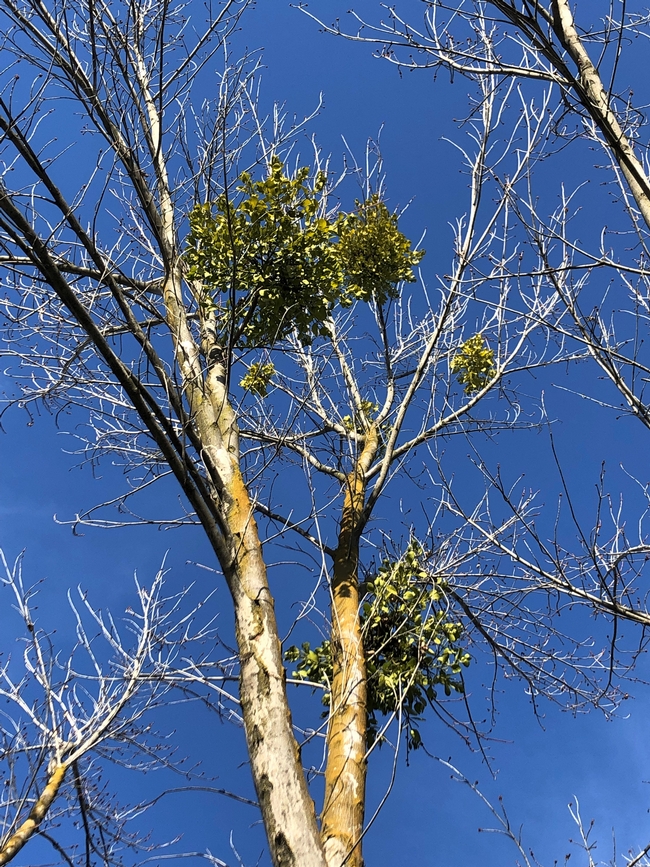What are mistletoes?
Mistletoes (Arceuthobium spp. [dwarf mistletoes], Phoradendron spp. [American mistletoes], and Viscum album. [European mistletoe]) are evergreen, flowering plants that parasitize trees and shrubs to acquire water and nutrients. All dwarf and American mistletoes occurring in California are native species whereas Viscum album was introduced to California from Eurasia. Although sometimes considered as undesirable pests, mistletoes may be important components of local ecosystems. For example, the seeds of some mistletoes can serve as food sources for various bird species. In fact, the name 'mistletoe' is likely derived from the Anglo-Saxon words 'mistel' (dung) and 'tan' (twig), which appropriately describes the role of birds in the spread of these plants.
Which species of mistletoe occur in California?
According to information currently available through CalFlora and The Jepson Herbarium, there are three species of dwarf mistletoe (Arceuthobium americanum, campylopodum, and douglasii) occurring in California. Dwarf mistletoes are parasites of conifers growing on Douglas fir (Pseudotsuga menziesii) and some Abies (fir), Pinus (Pine), and Tsuga (hemlock), depending on species. With respect to geographic location, A. douglasii is found in the high Cascade and the Klamath Ranges, A. americanum occurs in the high Cascade Range and the high Sierra Nevadas, and A. campylopodum is found throughout California except for the central valley, the south coast, and the Sonoran and Mojave Deserts.
The American mistletoes infect broadleaved trees and shrubs and some conifers in California; four species of Phoradendron have been reported: bolleanum, californicum, juniperinum, and leucarpum. According to current information available through CalFlora and the Jepson Herbarium, P. bolleanum infests multiple conifer species throughout California, except the central valley floor and the south coast. Phoradendron californicum is mainly found in the southern deserts and desert mountains on Acacia (acacia), Cercidium (palo verde), Olneya (ironwood) and Prosopsis (mesquite). Phoradendron juniperum can be found on Calocedrus (incense cedar) and Juniperus (juniper) throughout much of California, except for the central valley, the Sonoran Desert, the south coast and parts of the south coast range, and the bay area. Phoradendron leucarpum parasitizes a wide range of woody species (except conifers) throughout much of California including (but not limited to): Alnus (alder), Arctostaphylos (manzanita), Fraxinus (ash), Juglans (walnut), Populus (aspen), and Plantanus (sycamore).
Viscum album is limited in its geographic distribution within California (Sonoma County area) although its host range can include hundreds of species.
Phoradendron species parasitizing a street tree in Fresno. Photo by Lynn M. Sosnoskie.
General mistletoe biology.
The mistletoes can vary with respect to their appearance. Dwarf mistletoes produce small (P. californicum and P. juniperum have similarly small, scale-like leaves. Phoradendron bolleanum and leucarpum produce larger leaves (5-60 mm in length) that are yellow to green to grey-green. The foliage of European mistletoe is even larger (50-80 mm in length) and green (sometimes red) in color. Mistletoe species are dioecious, meaning that they produce male and female flowers on separate plants. Most flowers are small and inconspicuous. Flowering time varies both among and within genera. For example, A. americanum flowers between April and May, A. douglasii flowers between May and June, and A. campylopodum flowers between July and November. Fruits vary in size (2 to 10 mm) and color (brown and blue, white to pink), again, depending on species identity. While birds are responsible for dispersing some seed (i.e. V. album), other species disseminate their propagules by fruit explosion (i.e. A. campylopodum). Seeds germinate, and the hypocotyls grow until they reach a point where they can infect the plant (i.e. through a bud or a leaf base. Haustoria (slender projections from the roots of parasitic plants) penetrate the host tissue, eventually coming into the contact with the vascular system. It can take multiple years for the first shoots of mistletoe to appear on the host.
Phoradendrom stems, leaves, flowers and fruit. USDA-NRCS PLANTS Database / Britton, N.L., and A. Brown. 1913. An illustrated flora of the northern United States, Canada and the British Possessions. 3 vols. Charles Scribner's Sons, New York. Vol. 1: 639.
Managing mistletoe.
Although severe infestations can weaken trees, intensive mistletoe management (by removing infected branches or trees) isn't commonly undertaken unless a sensitive orchard species or historical tree is threatened. Homeowners can slow the growth and development of mistletoe by pruning out infected tissue in parasitized trees. If mistletoe occurs on a major branch that cannot be easily cut back, removing just the mistletoe, itself, can help to reduce the species ability to flower, set seed, and infest additional hosts. Where mistletoe is a regular problem, landowners should consider planting species that appear to be resistant, such as crape myrtle, ginkgo, and sycamore. More information about mistletoe control for homeowners can be found at: http://ipm.ucanr.edu/PMG/PESTNOTES/pn7437.html
Mistletoes: lore and legend.
Mistletoe has been interwoven into numerous myths, worldwide. Pliny the Elder wrote that mistletoe held on to the life of an oak tree when it went dormant in the winter. Many European ethic groups hung mistletoe around homes and barns to scare away witches and demons, while others thought that it promoted fertility. The tradition of kissing under a mistletoe sprig is also shrouded in legend. In one Norse tale, Frigga's son, Baldr, was killed by an arrow crafted from mistletoe (or else a sword named Mistletoe, depends on your source); following his death, Frigga set forth a declaration that the plant could no longer be made into a weapon and that she would kiss people who walked underneath it, instead.

